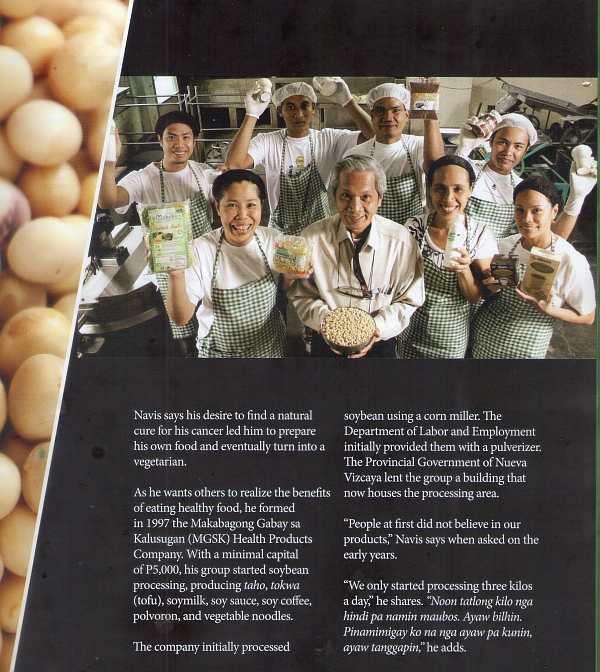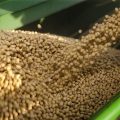The soybean brewed coffee “Healthy Rich” is targeted to be exported to Malaysia by2,400 boxes but this needs aid to beef up production to meet brisk demand for the protein-rich product.
Manufacturer of the Healthy Rich brand MGSK (Makabagong Gabay sa Kalusugan) produces 2,400 boxes of 3-In-1 soybean brew in a month.
This capacity, however, is intended for the local market.
“We need to at least double this capacity so we can entertain the order from Malaysia,” said Ric Navis Jr., MGSK Manager. “We simply cannot commit to export our existing production capacity. We also need to satisfy the local market.”
In 2011, MGSK obtained a P2.5 million financial grant from the Bureau of Agricultural Research (BAR) which was used to commercialize its small-scale soybean products.
It has so far completed the nutritional analysis for 16 product lines, developed its packaging, secured small equipment for packaging, and improved its formulation.
It is now in the process of securing Halal certification. This will be funded by the BAR grant’s last tranche release.
“We import soybean heavily. If there is a way for farmers to be encouraged to plant soybean by showing them the market through value added products, BAR will be ready to support these programs,” said BAR Director Nicomedes P. Eleazar.
MGSK soy-based products include Soybean Brew (three variants) soy milk, cold taho, tokwa, polvoron, ice cream and pastillas. Soybean is also a major ingredient in MGSK Veggie Noodles. The soy bean brew variants are : 3-in-1 Soybrew, Instant Hot Soybrew and Soybrew for Coffee makers.
More than P 2 million had been poured by MSGK through its own equity into the processing center in Busilac, Nueva Vizcaya. Some of the funds were provided by the Department of Science and Technology and Small Business Guarantee and Finance Corp.
The plant already has Food and Drug Administration registration and Good Manufacturing Practice certification.
The BAR grant augmented MGSK resources to enable it to produce market and regulation compliant products. The modest investment directly employs 15 people.
“The existing processing center will also serve as product development showcase for processed food. The experience gained thru the MGSK-BAR collaboration will enable MGSK to replicate project in other areas,” Navis said.
On top of the soy brew capacity, the processing plant can only produce monthly about 6,000 bottles of soy milk; 6,000 cups of cold taho; 4,000 plastic 200-gram pouches.

Soybean source
The biggest bulk of soybean raw materials is still being sourced in Divisoria. This is why Navis wants to help promote local soybean production.
MGSK maintains a 1.5-hectare farm in Bayombong, Nueva Vizcaya. About 25 percent of the area is devoted to soybean. This farm gives jobs to about 10 farmers in the area. Another three hectare is being mulled for soybean production. It also arranging supply arrangements with soybean growers in Diadi and Bayombong.
MGSK soybean farm yields only 80 kilos of soybean from one kilo of soybean seeds.
However, it hopes to double this yield through trial and error.
“We’re doing our own experiments, but we’re not really after yield quantity yet. Our aim is to grow soybean the organic way. We don’t use chemical fertilizers, insecticides, or pesticides,” he said.
Soy milk feeding
MGSK’s soymilk had been included in the nutrition program of the Nueva Vizcaya local government unit (LGU) to be funded under the Provincial Development Investment Plan of Nueva Vizcaya.
The LGU issued an initial purchase order for 2,000 plastic pouches of soy milk.
“There is a drive in Nueva Vizcaya for ‘no soft drinks’ for school children. Here, we could serve soy milk to them,” he said. MGSK will expand its linkage with other GOs and NGOs with health advocacy.
OTOP
MGSK receives help from the Department of Trade and Industry on the marketing of its products.
MGSK processed soybean products are also included as OTOP (One town One Product) products of Bayombong, Nueva Vizcaya.
DA
MGSK is aligning its program with the agriculture/” title=”View all articles about Department of Agriculture here”>Department of Agriculture (DA) which has a thrust to encourage soybean planting.
Government seeks to expand soybean area as it is a raw material for food and feed industries. These businesses depend on imported whole soybeans, soybean meal, and soybean oil.
Soybean importation has consistently risen over the years from 25 metric tons (MT) in 1986 to 140,000 MT in 1994, and close to 300,000 MT in 2000.
Soybean meal importation amounted to some P13 billion as of 2002. Price of soybean is very encouraging for Filipino farmers as it peaked to more than P$600 per MT in 2008 with a local equivalent of more than P26 per kilo. As of 2011, price was around $550 per hectare or about P23-P25 per kilo locally.
Health benefits
Local soybean demand has the potential to grow given promotional works on its being a healthy heart-inducing and anti-cancer food (isoflavones). Recipes on soybean is set to be released by BAR to encourage inclusion of soybean in Filipino meals.
Besides, Filipinos are among the least soybean eaters. Annual per capital consumption of soybean in Southeast Asia is nine kilos in Indonesia, 8.9 kilos in Singapore, 3.5 kilos in Malaysia, 2.5 kilos in Thailand, and only 0.4 kilo in the Philippines.
Soybean is also now being touted as a “wonder crop” considering the richness of protein, carbohydrate, fat, and ash in its cotyledon, hypocotyls, whole bean, and hulls. MGSK boasts of soybean as containing rich protein that is two times that of animal meat, five times that of bread, four times of egg, and 12 times of milk.
It helps increase bone density, preventing osteoporosis and is a good dietary fiber. It contains oligosaccharides which normalize intestinal environment by controlling pH and production of organic acids and shortchain fatty acids. It can substitute animal protein, reducing plasma total cholesterol and low-density lipoprotein (LDL or bad cholesterol) by 20 percent. It has omega 3 fatty acid as those in fish oil.
Farm expansion
DA and its other agencies like the High Value Commercialization and Development Program and BAR have an integrated program for soybean. The DA-BAR program includes establishment of research facilities, soil fertility and climate mapping using geographic information system, development of good varieties including those for exotic species, and mechanization and post harvest program.
The country’s present soybean area is less than 1,000 hectares. These are mostly in Surigao del Sur and Negros Oriental. However, the project has a target to expand soybean area from less than 1,000 hectares to 14,075 hectares by 2016.
Specific targets are 3,745 hectares for 2013; 7,115 hectares in 2014, and 10,580 hectares in 2015. Provincial area target by 2016 is 50 hectares each in Regions 3, 4B, 5, and ARMM; 100 hectares each in Region 1 and 6; 200 hectares in Cordillera; 500 hectares each in Region 2, 9, and 10; 175 in Region 4A; and 400 hectares in Regions 7, 8 and 13,000 hectares in Region 13.
Cagayan Valley
Soybean planting is particularly being revived in Cagayan Valley which used to have 500 hectares for soybean in the 1990s.
“While it is suitable for production in Region 2, it has to be revived, sustainably and safely produced for household use as food and feed ingredient,” according to a CVIARC Soybean Roadmap crafted by a group led by Rose Mary G. Aquino.
Cagayan Valley targets to produce 10,000 to 20,000 kilos of certified soybean seeds.
An enterprise model is envisioned from three farming communities. “We will need provisions for soybean grinding machine for milk and sepal extraction. We will do profiling of local soybean food and feed processors so we may link them to farmers,” according to the report.
Income
For organic soybean, net income derived from planting had an average of P22,843 per hectare in Cagayan Valley. Yield is at 1,134 to 1,542 kilos per hectare.
There is presently an assured market for 511,900 kilos of soybean in Cagayan Valley. These are from MGSK, 6,000 kilos; Esperanza Multipurpose Cooperative, 4,500 kilos; Sanitarium Hospital, 500 kilos; Ilagan Taho, 900 kilos; and Decena Farm, 500,000 kilos for feed.
In Maddela, Quirino, 19 farmers tilling 10.55 hectares enjoy an average income of P35,000 per hectare. Yield average is 1,600 kilos per hectare. Soybean here is intercropped with citrus and banana. In Kayapa, Nueva Vizcaya, 39 farmers tilling five hectares posted an average income of P31,090 per hectare. They intercrop soybean with upland vegetables.
Soybean board
A Philippine Soybean Board (PSB) will be put up in an aim to raise soybean growers’ competitiveness. It hopes to emulate the National Corn Competitiveness Board that helped raise global competitiveness of local corn.
The DA-BAR project will design an incentive program to create a community of soybean planters. Three zonal seed banks will be put up. These will be in Luzon to be managed by the Cagayan Valley Integrated Agriculture Research Center (IARC); Visayas—La Granja National Crop Research Development Center in Negros; and Mindanao—Central Mindanao IARC. Small scale irrigation systems and small processing equipment for pooling farmers’ produce will be set up. A Philippine Quality Standard will be put up for organic soybean.
###
For any questions, please call Mr. Ric Navis Jr., 0906-448-0472, 0906-266-8825, Ms. Rose Mary G. Aquino, 0915-462-2438; for interview requests, please call Ms. Analiza C. Mendoza, 0921-338-3816







Your writing has impressed me. It’s simple, clear and precise. I will definitely recommend you to my friends and family. Regards and good luck Thanks
<a href="http://sumatioilindustries.com/"> organic soyabean meal </a>
Lets have a great business with your soya coffee!im interested so much!!!i will call your contact numbers to have buss partnership with you?
http://www.fnur.bu.edu.eg/
http://www.fnur.bu.edu.eg/fnur/index.php/main-news/item/422-2013-12-10-10-18-01
http://www.fnur.bu.edu.eg/fnur/index.php/main-news/item/421-2013-12-10-09-48-39
http://www.fnur.bu.edu.eg/fnur/index.php/main-news/item/419-2013-12-09-07-21-12
http://www.fnur.bu.edu.eg/fnur/index.php/main-news/item/420-2013-12-10-09-48-38
http://www.fnur.bu.edu.eg/fnur/index.php/main-news/item/417-2013
http://www.fnur.bu.edu.eg/fnur/index.php/main-news/item/418-2013-12-09-07-17-28
http://www.fnur.bu.edu.eg/fnur/index.php/main-news/item/415-2013-12-03-08-09-23
http://www.fnur.bu.edu.eg/fnur/index.php/main-news/item/416-2013-12-03-08-25-21
http://www.fnur.bu.edu.eg/fnur/index.php/main-news/item/413-2013-11-21-07-50-21
http://www.fnur.bu.edu.eg/fnur/index.php/main-news/item/414-2013-11-25-09-38-30
http://www.fnur.bu.edu.eg/fnur/index.php/main-news/item/411-2013-11-20-08-11-53
http://www.fnur.bu.edu.eg/fnur/index.php/main-news/item/412-2014
http://www.fnur.bu.edu.eg/fnur/index.php/main-news/item/409-2013-2014
http://www.fnur.bu.edu.eg/fnur/index.php/main-news/item/410-2013-11-13-17-25-28
http://www.fnur.bu.edu.eg/fnur/index.php/main-news/item/407-2013-11-09-08-51-15
http://www.fnur.bu.edu.eg/fnur/index.php/main-news/item/408-2013-11-13-11-55-53
http://www.fnur.bu.edu.eg/fnur/index.php/main-news/item/405-2013-11-09-08-42-05
http://www.fnur.bu.edu.eg/fnur/index.php/main-news/item/406-2013-11-09-08-46-10
http://www.fnur.bu.edu.eg/fnur/index.php/main-news/item/403-2013-11-09-08-25-45
http://www.fnur.bu.edu.eg/fnur/index.php/main-news/item/404-2013-11-09-08-28-15
http://www.fnur.bu.edu.eg/fnur/index.php/main-news/item/400-2013-11-09-07-50-13
http://www.fnur.bu.edu.eg/fnur/index.php/main-news/item/401-2013-11-09-08-03-31
http://www.fnur.bu.edu.eg/fnur/index.php/main-news/item/398-2013-11-09-07-29-40
www.fnur.bu.edu.eg/fnur/index.php/main-news/item/399-2013-11-09-07-43-49
http://www.fnur.bu.edu.eg/fnur/index.php/main-news/item/397-eugen-ionesco
http://www.fnur.bu.edu.eg/fnur/index.php/main-news/item/402-2014-2013
http://www.fnur.bu.edu.eg/fnur/index.php/main-news/item/395-2013-11-02-09-07-04
http://www.fnur.bu.edu.eg/fnur/index.php/main-news/item/396-45-2013-10-23
http://www.fnur.bu.edu.eg/fnur/index.php/main-news/item/390-2013-10-29-11-53-44
http://www.fnur.bu.edu.eg/fnur/index.php/main-news/item/393-2013-10-29-11-57-48
http://www.fnur.bu.edu.eg/fnur/index.php/main-news/item/392-2013-10-29-11-56-48
http://www.fnur.bu.edu.eg/fnur/index.php/main-news/item/394-2013-10-29-12-02-18
http://www.fnur.bu.edu.eg/fnur/index.php/main-news/item/388-2013-201
congrats